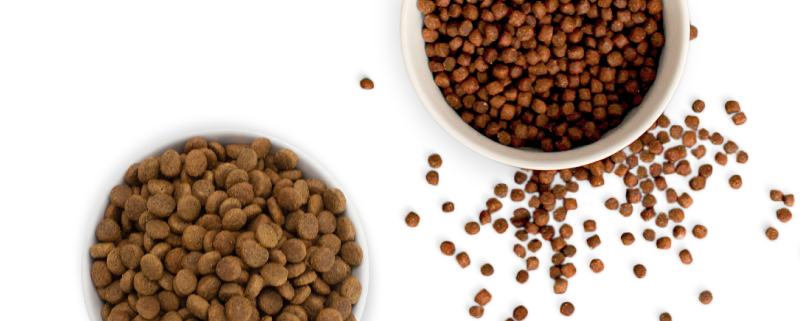1. Buff P.R., Carter R.A., Bauer J.E., Kersey J.N. (2014) Natural pet food: A review of natural diets and their impact on canine and feline physiology. J. Anim. Sci.;92:3781–3791. doi: 10.2527/jas.2014-7789
2. Axelsson E., Ratnakumar A., Arendt M.L., Maqbool K., Webster M.T., Perloski M., Liberg O., Arnemo J.M., Hedhammar A., Lindblad-Toh K. (2013) The genomic signature of dog domestication reveals adaptation to a starch-rich diet. Nature; 495:360–364. doi: 10.1038/nature11837
3. The European Pet Food Industry (FEDIAF) Nutrition [ Accessed on 3 June 2021] Available online: http://www.fediaf.org/self-regulation/nutrition/
4. Gentle World Good Nutrition for Healthy Vegan Dogs [Accessed on 3 June 2021] Available online: http://www.webcitation.org/6ineIZmNQ
5. Peden J. (1999) Vegetarian Cats & Dogs. 3rd ed. Harbingers of a New Age; Troy, MT, USA
6. Semp P.-G. (2014) Master’s Thesis. Veterinary University of Vienna; Vienna, Austria: Vegan Nutrition of Dogs and Cats
7. Brown W.Y., Vanselow B.A., Redman A.J., Pluske J.R. (2009) An experimental meat-free diet maintained haematological characteristics in sprint-racing sled dogs. Br. J. Nutr.;102:1318–1323. doi: 10.1017/S0007114509389254
8. People for the Ethical Treatment of Animals (PETA) Dog Health Survey. [Accessed on 3 June 2021]
9. Marks S.L., Rankin S.C., Byrne B.A., Weese J.S. (2011) Enteropathogenic bacteria in dogs and cats: Diagnosis, epidemology, treatment, and control. J. Vet. Intern. Med.;25:1195–1208. doi:
10. Carrión P.A., Thompson L.J., Motarjemi Y., Lelieveld H., (2014) Food Safety Management: A Practical Guide for the Food Industry. Academic Press; London, UK:. pp. 379–395
11. Knight, A. and Leitsberger, M. (2016) Vegetarian versus meat-based diets for companion animals. Animals 6, 57.
12. Boyer C.I., Jr., Andrews E.J., deLahunta A., Bache C.A., Gutenman W.H., Lisk D.J. (1978) Accumulation of mercury and selenium in tissues of kittens fed commercial cat food. Cornell Vet.;68:365–374.
13. Anonymous. Your Pet’s Dog Food Could Be Dangerous. [Accessed on 8 December 2014] Available online: http://www.wavy.com/Global/story.asp?S=1018127&nav=23iiCT4S.
14. Porecca K. (1995) Personal letter to James Peden re: Interview of University of California (Davis), North Carolina State University, and University of Guelph Researchers investigating the connection between dilated cardiomyopathy and diet
15. Perry T. What’s Really for Dinner? [Accessed on 7 July 2016] Available online: http://www.webcitation.org/6ipEL5YVR.
16. https://www.bordercolliefanclub.com/bramble-the-vegan-dog-lives-to-189-years/
17. https://aminoapps.com/c/vegan/page/blog/vegan-dog-lives-to-27-years-of-age/N4ai_MuaRE5qNoYVN1DN85ap0GVjz3j
18. https://v-dog.com/blogs/v-dog-blog/vegan-diets-for-dogs-what-about-longevity
19. https://www.fediaf.org/39-prepared-pet-foods/80-understanding-labels.html
20. https://vetnutrition.tufts.edu/2016/07/vegan-dogs-a-healthy-lifestyle-or-going-against-nature/
21. https://www.petmd.com/dog/nutrition/7-interesting-facts-about-your-dogs-digestive-system
22. http://www.vivo.colostate.edu/hbooks/pathphys/digestion/pregastric/dogpage.html
23. Félix AP, Zanatta CP, Brito CB, et al. (2013) Digestibility and metabolizable energy of raw soybeans manufactured with different processing treatments and fed to adult dogs and puppies. J Anim Sci;91:2794–2801.
24. Carciofi A, de-Oliviera L, Valério A, et al. (2009) Comparison of micronized whole soybeans to common protein sources in dry dog and cat diets. Anim Feed Sci Technol;151:251–260.
25. Yamka R, Kitts S, Harmon D. (2005) Evaluation of low-oligosaccharide and low-oligosaccharide low-phytate whole soya beans in canine foods. Anim Feed Sci Technol;120:79–91.
26. Hill D. (2004) Alternative proteins in companion animal nutrition, in Proceedings. Pet Food Assoc Canada Fall Conf;1–12
28. Hazewinkel HA, Tryfonidou MA. (2002) Vitamin D3 metabolism in dogs. Mol Cell Endocrinol;197:23–33.
Boland R, Skliar M, Curino A, et al. (2003) Vitamin D compounds in plants. Plant Sci;164:357–369.
29. Jäpelt RB, Jakobsen J. (2013) Vitamin D in plants: a review of occurrence, analysis, and biosynthesis. Front Plant Sci;4:136
30. Knight, A. and Leitsberger, M. (2016). Vegetarian versus meat-based diets for companion animals. Animals 6, 57.
31. Dodd SAS, Adolphe JL, Verbrugghe A. (2018) Plant-based diets for dogs. J Am Vet Med Assoc. Dec 1;253(11):1425-1432. doi: 10.2460/javma.253.11.1425. PMID: 30451617.
32. https://www.petmd.com/dog/wellness/evr_dg_how_long_do_dogs_live [Accessed 2 June 2021]
33. https://www.utep.edu/leb/pleistnm/stuff/stuff2.htm [Accessed 2 June 2021]
34. M S Martins, N K Sakomura, D F Souza, F O R Filho, M O S Gomes, R S Vasconcellos, A C Carciofi (2014) Brewer’s yeast and sugarcane yeast as protein sources for dogs, J Anim Physiol Anim Nutr (Berl) 2014 Oct;98(5):948-57. doi: 10.1111/jpn.12145.
35. Christina Golder, James L Weemhoff, Dennis E Jewell (2020) Cats Have Increased Protein Digestibility as Compared to Dogs and Improve Their Ability to Absorb Protein as Dietary Protein Intake Shifts from Animal to Plant Sources 24;10(3):541. doi: 10.3390/ani10030541.
36. Henkel J. (2000) Soy. Health claims for soy protein, questions about other components. FDA Consum ;34(3):13–15,18–20.
37. Yalçin, Sakine & Erol, H & Özsoy, Bülent & Onbaşılar, I. (2008) Effects of the usage of dried brewing yeast in the diets on the performance, egg traits and blood parameters in quails. Animal : an international journal of animal bioscience. 2. 1780-5. 10.1017/S1751731108003170.
38. Rosser EJ (1993) Diagnosis of food allergy in dogs. Journal of the American Veterinary Medical Association; 203(2):259-262.
39. Mueller RS, Olivry T, Prélaud P. (2016) Critically appraised topic on adverse food reactions of companion animals: common food allergen sources in dogs and cats. BMC Vet Res.12:9. Published 2016 Jan 12. doi:10.1186/s12917-016-0633-8
40. https://www.kentlive.news/whats-on/shopping/salmonella-fears-spark-urgent-recall-4328262
41. https://www.food.gov.uk/news-alerts/alert/fsa-prin-31-2020
42. L. Martinez-Anton, M. Marenda, S.M. Firestone, R.N. Bushell, G. Child, A.I. Hamilton, S.N. Long, M.A.R. Le Chevoir (2018) Investigation of the Role of Campylobacter Infection in Suspected Acute Polyradiculoneuritis in Dog
43. https://www.foodsafetynews.com/2018/10/four-stec-infections-one-person-dead-after-exposure-to-raw-pet-food/
44. https://www.theguardian.com/science/2018/jan/12/scientists-criticise-trend-for-raw-meat-pet-food-after-analysis-finds-pathogens
45. https://news.cancerresearchuk.org/2015/10/26/processed-meat-and-cancer-what-you-need-to-know/
46. D.F. Merlo, L. Rossi, C. Pellegrino, M. Ceppi, U. Cardellino, C. Capurro, A. Ratto, P.L. Sambucco, V. Sestito, G. Tanara, V. Bocchini (2008) Cancer Incidence in Pet Dogs: Findings of the Animal Tumor Registry of Genoa, Italy
https://doi.org/10.1111/j.1939-1676.2008.0133.x , journal of veterinary internal medicine
47. https://www.pfma.org.uk/_assets/docs/White%20Papers/PFMA-Obesity-Report-2019.pdf
48. https://www.pfma.org.uk/grain-free-factsheet
49. https://fediaf.org/images/FEDIAF_Nutritional_Guidelines_2020_20200917.pdf
50. https://www.ksvdl.org/resources/documents/dcm-forum/Confidential-Abstract-for-release-October-14-2020-Final.pdf
51. https://www.ksvdl.org/resources/documents/dcm-forum/DCM-Forum-SolomonOpening-Remarks.pdf
52. https://stpetersbark.com/finally-theres-no-evidence-linking-grain-free-diets-and-non-hereditary-heart-conditions-in-dogs/
53. Okin GS (2017) Environmental impacts of food consumption by dogs and cats. PLoS ONE 12(8): e0181301. https://doi.org/10.1371/journal.pone.0181301

